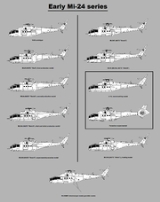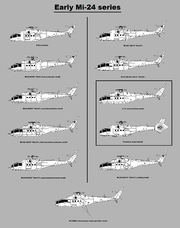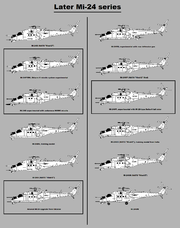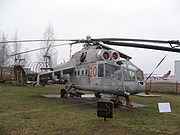
Mil Mi-24 variants
Encyclopedia







Mil Mi-24
The Mil Mi-24 is a large helicopter gunship and attack helicopter and low-capacity troop transport with room for 8 passengers. It is produced by Mil Moscow Helicopter Plant and operated since 1972 by the Soviet Air Force, its successors, and by over thirty other nations.In NATO circles the export...
went from drawing board in 1968 to first test-flights in less than eighteen months. The first models were delivered to the armed forces for evaluation in 1971. The Hind-A did have a number of problems: lateral roll, weapon sighting problems, and limited field of view for the pilot. A heavy redesign of the aircraft front section solved most of these problems.
- V-24 — The first version, twelve prototypes and development aircraft. The first V-24 mockup resembled the Bell UH-1A Huey. Later models resembled the future Hind-A, one of which was modified in 1975 as A-10 for speed record attempts with wings removed and faired over and with inertia-type dampers on the main rotor head. The A-10 reached a speed of 368 km/h.
- Mi-24 (Hind-A) — Other early versions were the armed assault helicopter, which could carry eight combat troops and three crew members. It could also carry four 57-mm rocket pods on four underwing pylons, four MCLOS 9M17 Phalanga (AT-2 Swatter) anti-tank missiles on two underwing rails, free-fall bombs, plus one 12.7-mm machine-gun in the nose. The Mi-24 was the first production model.
- Mi-24B (Hind-A) — Experimental series of Hind-A, one of which was used to test the FenestronFenestronA Fenestron is a shrouded tail rotor of a helicopter that is essentially a ducted fan. The housing is integral with the tail skin, and, like the conventional tail rotor it replaces, is intended to counteract the torque of the main rotor...
tail rotor. - Mi-24F (Hind-A) — Modified Hind-A with seven reinforcing ribs on the port fuselage aft of the wing and the SRO-2M Khrom ("Odd Rods") IFFIdentification friend or foeIn telecommunications, identification, friend or foe is an identification system designed for command and control. It is a system that enables military and national interrogation systems to identify aircraft, vehicles, or forces as friendly and to determine their bearing and range from the...
antennaAntenna (radio)An antenna is an electrical device which converts electric currents into radio waves, and vice versa. It is usually used with a radio transmitter or radio receiver...
relocated from the canopy to the oil cooler. The APU exhaust was also extended and angled downwards. The designation may be unofficial. - Mi-24A (Hind-B) — The Mi-24A was the second production model. Both the Mi-24 and Mi-24A entered Soviet Air Force service in 1972. Lacks the four-barrel Yak-B 12.7mm machine gun under the nose.
- Mi-24U (Hind-C) — Training version without nose gun and wingtip stations.
- Mi-24BMT - Small number of Mi-24s converted into minesweepers.
- Mi-24D (Hind-D) — The Mi-24D was a purer gunship than the earlier variants. It entered production in 1973. The Mi-24D has a redesigned forward fuselage, with two separate cockpits for the pilot and gunner. It is armed with a single 12.7-mm four-barrel Yak-B machine-gun under the nose. It can carry four 57-mm rocket pods, four SACLOS 9M17 Phalanga anti-tank missiles (a significant enhancement compared to the MCLOS system found on the Mi-24A), plus bombs and other weapons. One Mi-24D was sold to Poland in January 1996 and was used by the WTD 61 in ManchingManchingManching is a municipality in the district of Pfaffenhofen, in Bavaria, Germany. It is situated on the river Paar, 7 km southeast of Ingolstadt...
during 1994 for tests with the head of a Hawk missile in place of the chin-mounted gun. This version also had an unidentified modification in the rear cabin window on the starboard side. - Mi-24PTRK — This version was the Mi-24D modification that was used for testing the Shturm V missile system for the Mi-24V.
- Mi-24DU — Small numbers of Mi-24Ds were built as training helicopters with doubled controls.
- Mi-24V (Hind-E) — Later development led to the Mi-24V which entered production in 1976 and was first seen by the west in the early 1980s. It armed with the more advanced 9M114 Shturm (AT-6 Spiral). Eight of those missile are mounted on four outer wing pylons. It was the most widely produced version with more than 1,500 made. In Polish service this aircraft is designated Mi-24W. One Mi-24V was referred to as Mi-24T for unknown reasons.
- Arsenal Mi-24V upgrade — Ukrainian upgrade for Mi-24V
- Mi-24P (Hind-F) — The gunship version, which replaced the 12.7-mm machine-gun with a fixed side-mounted 30-mm GSh-30K twin-barrel cannon.
- Mi-24P-2 — Upgraded Mi-24P.
- Mi-24G (Hind-F) — Custom Mi-24P with a gun on the starboard side
- Mi-24TECh-24 "Mobile Repair Shop" — Experimental Hind-F to test abilities for recovery of downed aircraft.
- Mi-24VP (Hind-E Mod) — Development of Mi-24V made in 1985 which replaced the machine-gun with twin 23-mm cannons in a movable turret. Entered service in 1989, but only 25 were made before production ended the same year. One Mi-24VP flew with the Delta-H tail rotor of the Mi-28.
- Mi-24VU (Hind-E) — Indian training version of Mi-24V "Hind-E".
- Mi-24VD — This version was produced in 1985 to test a rear defensive gun.
- Mi-24RKhR (Hind-G1) — NBCWeapons of mass destructionA weapon of mass destruction is a weapon that can kill and bring significant harm to a large number of humans and/or cause great damage to man-made structures , natural structures , or the biosphere in general...
reconnaissance model, which is designed to collect radiation, biological and chemical samples. It was first seen during the 1986 Chernobyl nuclear disasterChernobyl disasterThe Chernobyl disaster was a nuclear accident that occurred on 26 April 1986 at the Chernobyl Nuclear Power Plant in Ukraine , which was under the direct jurisdiction of the central authorities in Moscow...
. Also known as the Mi-24R, Mi-24RK and Mi-24RKh (Rch). - Mi-24RA (Hind-G1 Mod) — New version of the Mi-24V.
- Mi-24RR — Radiation reconnaissance model derived from the Mi-24R.
- Mi-24K (Hind-G2) — Army reconnaissance, artillery observation helicopter.
- Mi-24M — Upgraded model of the Mi-24.
- Mi-24VM — upgraded Mi-24V with updated avionics to improve night-time operation, new communications gear, shorter and lighter wings, and updated weapon systems to include support for the Ataka, Shturm and Igla-V missiles and a 23-mm main gun. Other internal changes have been made to increase the aircraft life-cycle and ease maintenance. The Mi-24VM is expected to operate until 2015
- Mi-24VN (Hind-E) — (Mi-35O "Hind-E") A night-attack version based on an Mi-24V in Mi-24VM Stage 1 configuration.
- Mi-24PM — Upgraded Mi-24P using same technologies as in Mi-24VM.
- Mi-24PN — The Russian military has selected this upgraded Mi-24 to be their primary attack helicopter. The PN version has a TV and a FLIR camera located in a dome on the front of the aircraft. Other modifications include using the rotor blades and wings from the Mi-28 and fixed rather than retractable landing gear. The Russians received 14 Mi-24PNs in 2004 and plan on eventually upgrading all of their Mi-24s.
- Mi-24PS — Civil police or paramilitary version, equipped with a FLIR, searchlight, loudspeaker PA system and attachments for rappelling ropes.
- Mi-24V Ecological Survey Version — Environmental research version.
- Mi-25 — The export version of the Mi-24D.
- Mi-35 — The export version of the Mi-24V.
- Mi-35M — Export night attack version, is fitted with upgraded advanced avionics and sensor package, including night vision systems, GOES-342 electro-optical range finder/targeting system, GLONASSGLONASSGLONASS , acronym for Globalnaya navigatsionnaya sputnikovaya sistema or Global Navigation Satellite System, is a radio-based satellite navigation system operated for the Russian government by the Russian Space Forces...
/NAVSTAR navigation system, electronic multifunction displays, onboard computer, and jam-proof communications equipment. Also known as Mi-35M1. - Mi-35M2 — Updated version of the Mi-35M for the VenezuelaVenezuelaVenezuela , officially called the Bolivarian Republic of Venezuela , is a tropical country on the northern coast of South America. It borders Colombia to the west, Guyana to the east, and Brazil to the south...
n Army. - Mi-35M3 — Export Mi-24VM.
- Mi-35O — Export version of the Mi-24VN using a Mexican FLIR camera and a glass cockpit with upgraded avionics. Operated by Mexico only.
- Mi-35P — The export version of the Mi-24P.
- Mi-35U — Unarmed training version of the Mi-35.
- Mi-24 SuperHind Mk.II — Modern western avionics upgrade produced by South African company Advanced Technologies and Engineering (ATE).
- Mi-24 SuperHind Mk.III/IV — Extensive operational upgrade of the original Mi-24 including weapons, avionics and counter measures.
- Mi-24 SuperHind Mk.V — Newest version of the "SuperHind" with fully redesigned front fuselage and cockpit.
- Mi-24 Afghanistan field modifications — Passenger compartment armour and exhaust suppressors were often removed. Due to accidental firing while switching sides, the door gunner was given both a port and starboard gun. Extra rounds for the rocket pods to allow self-reloading near the battlefield and also heavy weapons for self defense were often carried.
- Tamam Mi-24 HMOSP — Israeli upgrade.
- Early Mi-28 mockups — First, an early production Mi-24 (probably Hind-A with wings removed) was fitted with an air data boom as an early test for the Mi-28's technologies. Later, a few Mi-24Ds were fitted up with the Mi-28's radome mount for testing the sighting-flight-navigational complex's abilities, and others had redesigned fuselages that closely resemble the future Mi-28, but with rounded cockpits.
External links
- Aeronautics.ru Mi-24
- http://www.fas.org/man/dod-101/sys/ac/row/mi-24.htm
- Mil V-24 at Stingray's List of Rotorcraft
- Mil Mi-24 at Stingray's List of Rotorcraft

